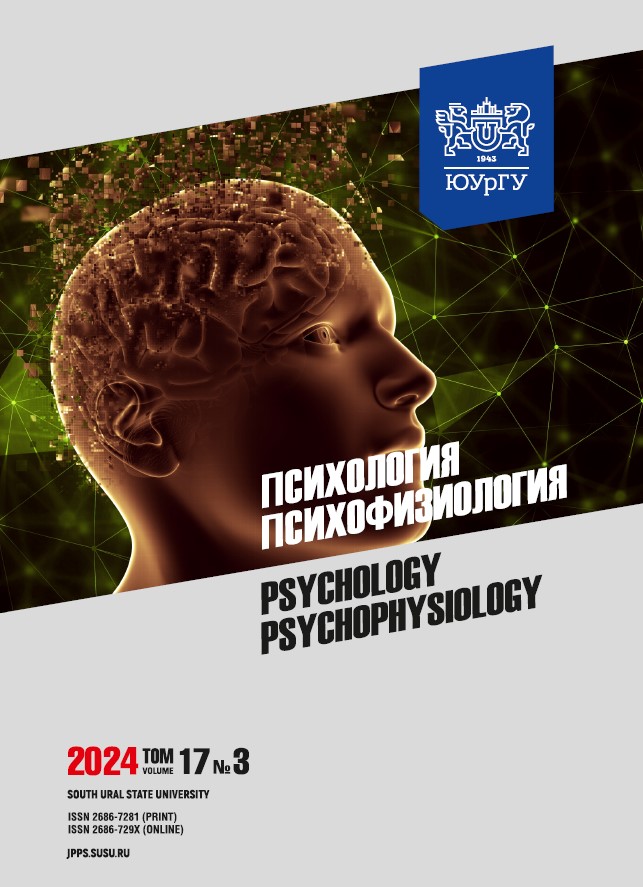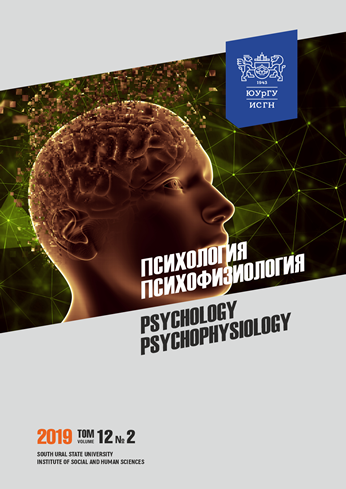The use of transcranial magnetic stimulation for the treatment of anxiety and depressive disorders
Abstract
Introduction. Depression and anxiety disorders are prevalent mental illnesses, demanding the exploration of new, non-pharmacological treatment approaches. Transcranial magnetic stimulation (TMS), a non-invasive method, has shown promising results in managing these conditions. Aims. This study aims to assess the effectiveness of TMS applied to the dorsolateral prefrontal cortex (DLPC) in reducing symptoms of anxiety and depression among patients undergoing medical rehabilitation. Materials and methods. This study involved 20 patients from the Siberian Clinical Center of the FMBA of Russia, Rehabilitation Department No. 1, aged 50 to 80 years, divided into control (n = 10) and experimental (n = 10) groups. Anxiety and depression levels were assessed using Beck scales before and after the intervention. Patients in the experimental group received 10 daily sessions of TMS to the left DLPC (10 Hz, 120% of motor threshold, 3000 pulses). Results. The experimental group demonstrated statistically significant reductions in anxiety and depression scores after the TMS course compared to the control group. Conclusion. DLPC-targeted TMS is a promising treatment for anxiety and depressive disorders. Further research with larger sample sizes is needed to optimize treatment protocols and investigate long-term effects.
Downloads
References
Elsevier. 2005:457.
2. Bakulin I.S., Poydasheva A.G., Medyntsev A.A., Suponeva N.A., Piradov M.A. Transcranial magnetic stimulation in cognitive neuroscience: Methodological basis and safety. Rossiiskii zhurnal kognitivnoi nauki = The Russian Journal of Cognitive Science. 2020;7(3):25–44. (in Russ.). DOI: 10.47010/20.3.2.
3. Timerbulatov I.F., Guliyev M.A. Transcranial magnetic stimulation (tms) in the treatment of anxiety disorders. Sotsialnaya i klinicheskaya psikhiatriya = Social and clinical psychiatry. 2021;31(1):104–109. (in Russ.).
4. Higgins S.E., George M.S. Brain Stimulation Therapies for the Clinician. Washington. American Psychiatric Association Publishing. 2009:203.
5. Kabachek V.V., Davydova N.S., Mezhennaya M.M., Davydov M.V. Anthropomorphic Brain Models Based on Magnetic Resonance Imaging. Tsifrovaya transformatsiya = Digital Transformation. 2022;28(2):61–69. (in Russ.). DOI: 10.35596/2522-9613-2022-28-2-61-69
6. Akhmadeeva L.R., Urazbakhtina Yu.O., Kamalova K.R. et al. Transcranial magnetic stimulation in neurology and neurorehabilitation. Mediko-farmatsevticheskii zhurnal “Puls” = Medical and pharmaceutical journal “Pulse”. 2019;21(12):55–59. (in Russ.). DOI: 10.26787/nydha-2686-6838-2019-21-12-55-59
7. Petrides M., Pandya D.N. Dorsolateral prefrontal cortex: comparative cytoarchitectonic analysis in the human and the macaque brain and corticocortical connection patterns. European Journal of Neuroscience. 1999;11(3):1011–1036. DOI: 10.1046/j.1460-9568.1999.00518.x
8. Аntonovich B.A., Mayorova L.A., Tsukarz E.E., Mosolov S.N. Resting State Networks in Depression and Perspectives for Personalized Transcranial Magnetic Stimulation. Sovremennaya terapiya psikhicheskikh rasstroistv = Current Therapy of Mental Disorders. 2019;3:2–11. (in Russ.). DOI: 10.21265/PSYPH.2019.49.35967
9. Ragimova A.A., Petelin D.S., Zakharova N.V. et al. Primenenie transkranialnoi magnitnoi stimulyatsii v psikhiatricheskoi i psikhonevrologicheskoi praktike [Application of transcranial magnetic stimulation in psychiatric and neuropsychiatric practice]. Moscow. Sechenov University Publ. 2022:150. (in Russ.).
10. Berman R.M., Narasimhan M., Sanacora G. et al. A randomized clinical trial of repetitive transcranial magnetic stimulation in the treatment of major depression. Biological Psychiatry. 2000;47(4):332–337. DOI: 10.1016/s0006-3223(99)00243-7.
11. Osuch E.A., Benson B.E., Luckenbaugh D.A. et al. Repetitive TMS combined with exposure therapy for PTSD: a preliminary study. Journal of Anxiety Disorders. 2009;23(1):54–59. DOI: 10.1016/j.janxdis.2008.03.015.
12. Isamukhamedova Yu., Usmankhodzhaeva A. Application of transcranial magnetic stimulation in neurology. Colloquium-Journal. 2020;13-2(65):59–61. (in Russ.).
13. Mantovani A., Pavlicova M., Avery D. et al. Long-term efficacy of repeated daily prefrontal transcranial magnetic stimulation (TMS) in treatment-resistant depression. Depression and Anxiety. 2012;29(10):883–890. DOI: 10.1002/da.21967.
14. Timerbulatov I.F., Guliev M.A. Transcranial Magnetic Stimulation in the Treatment of Generalized Anxiety Disorder. Psikhiatriya, psikhoterapiya i klinicheskaya psikhologiya = Psychiatry, Psychotherapy and Clinical Psychology. 2019;10(4):663–667. (in Russ.).
15. Bakulin I.S., Poidasheva A.G., Lagoda D.Yu. et al. Prospects for the Development of Therapeutic Transcranial Magnetic Stimulation. Nervnye bolezni = Nervous diseases. 2021;4:3–10. (in Russ.). DOI: 10.24412/2226-0757-2021-12371.
16. Voitenkov V.B., Ekusheva E.V., Maslyukova A.V. et al. Navigated transcranial magnetic stimulation: Question of accuracy. Meditsinskii alfavit = Medical alphabet. 2022;(21):27–31. (in Russ.). DOI: 10.33667/2078-5631-2022-21-27-31
17. Damyanovich E.V., Iznak E.V., Oleichik I.V. et al. Changes in the spatial organization of brain activity after combined antidepressive therapy including transcranial magnetic stimulation. Fiziologiya cheloveka = Human Physiology. 2019;45(1):29–36. (in Russ.). DOI: 10.1134/S0131164619010041
18. Prygunova T.M., Borisov V.Yu., Balandina O.V., Nasonova U.A. Functional brain mapping of significant areas of the brain using transcranial magnetic stimulation method. Meditsinskii almanakh = Medical almanac. 2022;2(71):6–12. (in Russ.).
19. Ispolatova E., Tsukarzi E. Post-Traumatic Stress Disorder: Morphological Substrates, Neural Networks and Transcranial Magnetic Stimulation Potential Benefits. Sovremennaya terapiya psikhicheskikh rasstroistv = Current Therapy of Mental Disorders. 2022;(3):45–49. (in Russ.). DOI: 10.21265/PSYPH.2022.78.73.005
20. Ustyuzhanin D.V., Rangus S.R., Usmanova I.I. et al. Functional MRI in patients with therapeutically resistant depression before and after transcranial magnetic stimulation. Rossiiskii elektronnyi zhurnal luchevoi diagnostiki = Russian electronic journal of radiology. 2023;13(2):24–37. (in Russ.). DOI: 10.21569/2222-7415-2023-13-2-24-37.
21. Zaborin A.S., Kartashov S.I. Spectroscopic features of the content of neurotransmitters during TMS therapy for catatonia. Vestnik Voennogo innovatsionnogo tekhnopolisa “Era” = Bulletin of the Military innovative technopolis “Era”. 2023;4(3):300–303. (in Russ.). DOI: 10.56304/S2782375X2303021X
References on translit
-Copyright (c) 2024 Psychology. Psychophysiology

This work is licensed under a Creative Commons Attribution-NonCommercial-NoDerivatives 4.0 International License.



